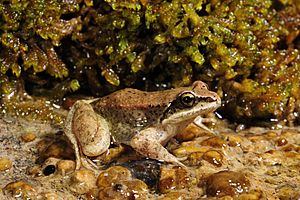Pyrenean frog facts for kids
Quick facts for kids Pyrenean frog |
|
|---|---|
 |
|
| Conservation status | |
| Scientific classification |
The Pyrenean frog (Rana pyrenaica) is a small type of frog that lives in the Pyrenees mountains. These mountains are found between France and Spain. This frog loves to live in fast-moving mountain streams and the areas around them. Sadly, the IUCN says it is an "endangered" animal. This means it is at risk of disappearing forever.
Contents
What Does the Pyrenean Frog Look Like?
The Pyrenean frog is the smallest brown frog in Europe. Adult frogs are usually about 5 cm (2.0 in) long from their nose to their bottom. Female frogs are a little bigger than males.
This frog has a rounded, blunt nose. Its nostrils are wider apart than its eyes. The ear drums (called tympani) are small and sometimes hard to see. The folds on its back are quite close together. Its back feet are fully webbed, except for the very tip of its fourth toe.
Pyrenean frogs can be creamy-brown, light brown, greyish-brown, reddish-brown, or olive-grey. They often have faint, blurry spots of greenish-brown or brown. Their back legs have light stripes. The upper lip is often noticeably pale. Their throat and belly are whitish, and sometimes their belly looks yellow or pink, especially under their thighs.
This frog is different from the common frog (Rana temporaria). The Pyrenean frog is smaller, has a less pointy nose, and its markings are not as clear.
Where Does the Pyrenean Frog Live?
The Pyrenean frog lives only in the Pyrenees mountains. Most of them are found on the Spanish side of the mountains. They live at high places, usually between 1,000 and 1,800 m (3,300 and 5,900 ft) above sea level.
You can find them from the Ordesa y Monte Perdido National Park all the way to the Roncal Valley in the Navarre region of Spain. There are also a few of these frogs on the French side of the mountains.
They like to live in and around fast-moving, rocky streams that don't have much plant life. They often share their home with another animal called the Pyrenean brook salamander (Calotriton asper). These frogs do not like still water ponds or lakes.
How Do Pyrenean Frogs Behave?
Adult Pyrenean frogs spend most of their time in the fast-flowing streams and rocky rivers where they live. However, young frogs spend more time on land.
These frogs are shy. If they sense danger, they quickly dive into the water. They hide in cracks in rocks or under stones to stay safe.
Pyrenean frogs hibernate during the winter months. This means they go into a deep sleep to save energy. They are active during both the day and night from about February to July.
Pyrenean Frog Reproduction and Life Cycle
Breeding happens after the snow has melted in the mountains. The female frog lays her eggs in batches. Each batch is covered in a jelly-like substance. She can lay up to 150 eggs in total. She usually places her eggs under stones, in cracks, or on the bottom of a stream.
Why is the Pyrenean Frog Endangered?
The International Union for Conservation of Nature (IUCN) says the Pyrenean frog is an "endangered species". This is because the number of these frogs is going down. The total area where they live is less than 5,000 square kilometres (1,900 sq mi). Even within this area, the groups of frogs are separated from each other.
There are several reasons why these frogs are in danger:
- Habitat Changes: Their homes are being changed by farming practices that use more land and chemicals.
- More Tourism: More people visiting the mountains can disturb the frogs and their homes.
- New Fish: Fish that are not naturally from the area are sometimes put into the streams. These new fish can eat the frogs' eggs or compete for food.
- Climate Change: Changes in the world's weather patterns might also be affecting them.
See also
In Spanish: Rana pirenaica para niños


